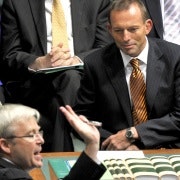The bloody-minded Banjos keepin' carbon in our air
Figures from the Australian Bureau of Statistics about average household expenditure show how repeal of the carbon price cannot save households very much.
Why not? Because households don't spend very much on power.
For a house that is struggling to pay all its bills, that may not sound like much comfort, but the amount we're talking about is relatively tiny.
The Australian Bureau of Statistics figures for 2009-2010 show that houses spend an average 2.63 per cent on 'domestic fuel and power'. That includes electricity, gas, bottled LPG and even firewood. It also includes those houses that pay an extra premium to buy GreenPower, to get 100 per cent renewable electricity.
This 2.63 per cent amounted to an average $32.52 per week, and for electricity alone $24.23 per week. If we apply CPI increases for electricity in subsequent years, we find $24.23 increases to $34.80 per week. There have been many years of high electricity price rises, well before the carbon price was introduced.
If we accept that repealing the carbon price will reduce electricity bills 9 per cent, as asserted by Tony Abbott, that equates to an average $3.13 saved per week on household electricity bills. Not exactly relief for the battlers.
In reality, Abbott is probably giving an optimistic appraisal of his policy, as one would expect. An article in The Conversation suggested a more realistic expectation would be a 5 per cent cut to electricity bills.
This is what the article had to say about how this affects your bill: “In Victoria – the state with the highest emissions intensity – carbon costs add 2.2 cents per kilowatt hour to electricity costs. Based on typical Victorian consumption of 5000 kilowatt hours per year, removing the carbon costs should equate to a reduction of roughly $110 per year.”
If, instead of typical Victorian electricity bills, we use the ABS national figures again, a 5 per cent saving is a whopping $1.74 per week saved off the average electricity bill, or about $90.48 per year. This is in line with the national emissions intensity being only about 0.85 tonnes CO2 per megawatt-hour, compared with about 1.2 tonnes in Victoria, where a higher carbon price would be charged.
For Beyond Zero Emissions, a carbon price with a 5 per cent emissions reduction target is 95 per cent less than what we should aim for. As it happens, our 2010 Zero Carbon Australia Stationary Energy Plan estimated that a comprehensive feed-in tariff to pay for zero emissions electricity would add about $8 per household per week ($416 per year).
So looking at this argument backwards, the carbon price, costing between $1.74 and $3.13 per week, is relatively cheap. For a few dollars more, a radical emissions cut is possible. And this action would take our entire electricity generation (stationary energy) sector to zero emissions.
Stationary energy's emissions in Australia are huge (54 per cent of the national total in 2007, as our Stationary Energy Plan noted). Cutting them to zero would just about halve our national emissions.
We know that climate change means more early fire seasons, more typhoons like Haiyan. It is becoming hard to deny that the costs of inaction are far too high. We should not stand for any weakening of climate action.
Whether we choose carbon pricing, emissions trading, feed-in tariffs, direct regulation, or any combination of the above, what this shows is that climate action will not cost the earth, and that we can easily do much more than we are presently doing.
BYGRAVE: What price this carbon price? November 21
Dr Stephen Bygrave is chief executive of Beyond Zero Emissions. He has worked nationally and internationally on climate change for 20 years.













